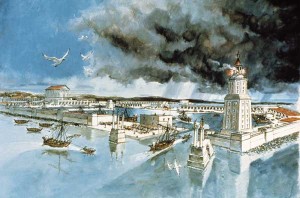The Palestinian Talmud, The Yerushalmi
 Lawrence H. Schiffman, From Text to Tradition, Ktav Publishing House, Hoboken, NJ, 1991.
Lawrence H. Schiffman, From Text to Tradition, Ktav Publishing House, Hoboken, NJ, 1991.
Although it is popularly known as the Jerusalem Talmud (Talmud Yerushalmi), a more accurate name for this text is either “Palestinian Talmud” or “Talmud of the Land of Israel.” Indeed, for most of the amoraic age, under both Rome and Byzantium, Jews were prohibited from living in the holy city, and the centers of Jewish population had shifted northwards, in the aftermath of the two revolts, to the Galilee and Golan regions. The Palestinian Talmud emerged primarily from the activity of the sages of Tiberias and Sepphoris, with some input, perhaps entire tractates, from sages of the “south” (Lydda, modern Lod) and the coastal plain, most notably Caesarea.
In these centers, the output of which included the exegetical Midrashim as well as the Palestinian Talmud, the activity of studying and transmitting the traditions of the tannaim occupied rabbis and their students from about 200 C.E. until the early fifth century. From that point on, because of anti-Semitism and economic difficulties, as well as abolition ofthe patriarchate, Jewish scholarship in Palestine played a secondary role.
In form, the Palestinian Talmud is arranged, essentially, as a commentary on the Mishnah. The Mishnah text which serves as its basis diverges in some ways from that used in the Babylonian Talmud. Exactly why this is the case is difficult to determine, and several theories have been advanced. More than likely the divergences resulted from the process of oral transmission and do not constitute evidence for separate recensions of the Mishnah, as has been suggested by some.
By far the greater part of the Palestinian Talmud emerged in the north, but the redaction of several tractates seems to have occurred in Caesarea, where the material was hurriedly and incompletely redacted. All told the Palestinian Talmud includes only thirty-nine of the sixty-three tractates of the Mishnah–the orders of Zera’im, Mo’ed, Nashim, and Neziqin, plus the first part of tractate Niddah of the order Tahorot. In view of the difficult circumstances under which it was compiled, it is unlikely that it ever included any other Mishnah tractates. The supposed Palestinian text of the order Qodashim, published only in 1905, has proven inauthentic.
The distribution of material in the Palestinian Talmud is often said to accord well with its provenance. Thus, since the agricultural laws were still observed in Palestine, it has extensive Gemara for tractates pertaining to agriculture, whereas such material is not found in the Babylonian Talmud. That the no longer relevant purity laws of most of Tahorot should be absent in both Talmuds is understandable. Tractate Niddah is an exception, since it deals with menstrual impurity and married life, an area of Jewish law which remained operative even after the destruction of the Second Temple. Yet it is difficult to explain the presence of the sacrificial law of the order Qodashim in the Babylonian Talmud and its absence in the Palestinian.
For the most part, the Palestinian Talmud was produced at the academy at Tiberias, which was under the patronage of the patriarchs. While the earlier patriarchs had been scholars, their successors were primarily political leaders and administrative officials. As the role of the patriarchs in the academies and the study of the oral Torah lessened, the heads of the Tiberias academy, beginning with Rabbi Yohanan, became extremely powerful and important in the development of the Palestinian tradition. The Palestinian Talmud bears Rabbi Yohanan’s mark, and that of his student and colleague Resh Lakish, on virtually every page.
Other prominent Palestinian amoraim included Hanina bar Hama at Sepphoris, Oshaya Rabbah at Caesarea, and Joshua ben Levi at Lydda (ca. 220-260 C.E.). An important contemporary of Yohanan and Resh Lakish (both of whom flourished ca. 250-290 C.E.) was Eleazar ben Pedat of Tiberias. Ammi bar Nathan and Assi at Tiberias, Abbahu at Caesarea (or, according to some, at Qatsrin in the Golan) followed them (ca. 290-320 C.E.). Rabbi Yonah and Rabbi Yose then led the Tiberias academy (ca. 320-350 C.E.).
The Palestinian amoraic chain of tradition came to an end not long afterwards, after the careers of Mana and Yose bar Abin (ca. 350-375 C.E.). Scholars in Caesarea, in the middle of the fourth century, brought to completion the initial tractates of Neziqin, Bava Qamma, Bava Mesia, and Bava Batra. Since these tractates have a different literary and linguistic form from that of the rest of the Palestinian Talmud, and feature a somewhat different group of scholars, most modern scholars have maintained that they were redacted separately. The rest of the Palestinian Talmud was somewhat hastily redacted out of developing sugyot in the fifth century, completed soon after the dismantling of the patriarchate. This final redaction took place at Tiberias. Because the Palestinian Talmud was completed during the period in which the named amoraim flourished, it lacks the last layer of anonymous material (setam) that occurs in the Babylonian Talmud. This is one of the main reasons for the difficulties encountered in studying the Palestinian Talmud.
The character of the Palestinian Talmud has often been misunderstood. At first glance it seems to be simply a collection of baraitot, amoraic dicta, and aggadot, arranged with no internal logic. However, the Palestinian Talmud does indeed develop logical arguments in its discussions and is organized to indicate this logic. It lacks the connecting terminology that was added to the Babylonian Talmud during the last stages in its history because no comparable stage took place in Palestine.



